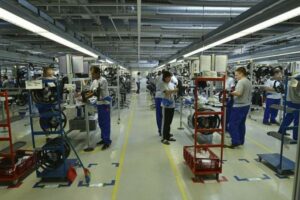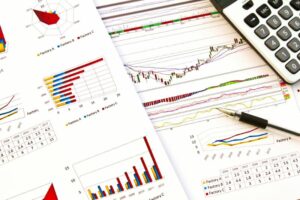 The National Commission for the establishment of the National Plan for the Adoption of Euro advanced as synthetic benchmarks for the adoption of the single European currency an average annual economic growth rate of 4%, in order to reach the minimum level of 70% of the Eurozone development (EZ19) in six years or an average annual growth rate of 5%, in order to be achieve that in just four years.
The National Commission for the establishment of the National Plan for the Adoption of Euro advanced as synthetic benchmarks for the adoption of the single European currency an average annual economic growth rate of 4%, in order to reach the minimum level of 70% of the Eurozone development (EZ19) in six years or an average annual growth rate of 5%, in order to be achieve that in just four years.
In the scenario based on which Romania intends to achieve 75% of the EZ19 average (the most appropriate level for Romania’s economy, according to the Commission’s report), that can be achieved within nine years (if the average growth rate maintains at 4% per year) or in six years in the context of an average growth rate of 5% per year.
In a simplified way, in order to understand what we are facing in order to achieve this objective (as stated in the EU accession treaty and from which – note- we are in the temporary derogation regime), let us bring the situation to a basic arithmetic level, without making a meticulous, „pharmacy-like” calculation (anyway spoiled by various factors from the reality).
Over the last four years on which Eurostat reported data on GDP per capita at the parity of purchasing power standards (it sounds pretentious but it is nothing more than an adjustment to prices in each country, to ensure the comparability at the European level), the EZ19 remained constant at 106% of the EU average.
Romania reached 62.5% of the EU average in 2017 (Eurostat kindly rounded our result up to 63%). Based on that, for the minimum level of 70% of the EZ19 average, we should reach about 74.5% of the EU average, namely to advance (relative to a moving target) by 12 percentage points (pp.).
They can be recovered for elementary divisibility purposes, to achieve the minimum limit set, or by 2 pp. in six years or by 3 pp. in four years. The simplified combinations are 4% for us and 2% for the average increase in EZ19 or, respectively, 5% for us and 2% for the average increase in the Eurozone countries.
If we resume the same logic, for the optimal 75% of the average EZ19 in GDP per capita, we should reach about 80% of the EU average. So we have to recover 18 percentage points starting from about 62%, where we are now. Distributed, for the same divisibility and simplicity reasons, by 2 pp. within nine years or by 3 pp. within six years.
If we draw the line and mix the two scenarios (the third, ultra prudent, with 80% of the Eurozone average, would mean for us to reach the current position of Slovenia or the Czech Republic related to EZ19, that is 85% of the EU average, so we do not insist on it) the following versions result:
- Theoretically, we could achieve a sensational 5% this year and the next three years (values above this threshold are officially forecasted – see the 2018 summer preliminary forecast, which mentions an average of 5.5% and a „landing” at 5% as of 2021 onwards). It is hard to believe though that we could adopt the euro in 2022. We have already lost 2021 from this point of view.
First, because we had to enter the ERM II anteroom even since 2019 and especially because we will not be able to meet all Maastricht criteria. Achieved at about the end of 2014, but from which we started to lose on the way. And which we will have to bring back on the right track, prior to the official notice on our intention to adopt the euro.
- Most likely, we will go with a mix of circumstances, either 5% per year to target the optimum of 75% of EZ GDP per capita of or 4% per year and risk to join with a minimum of 70% of EZ average. As we could say, an increase of 4% -5% per year and a limit of 70% – 75% of the targeted average. We just wrote EZ, as maybe Croatia and/or Bulgaria can help us a little so that we join EZ20 or EZ21. That is, we would use the euro in 2024 in our daily shopping (beyond just the houses, cars and telephone bills to which we are already used).
- Prudent, but distant in time, it would be to wait until 2027 so that we can also cover the option of 4% average annual growth to an optimal recommended level of 75% of the EZ average. Or to successfully maintain our engines speed at the 5% average, to go with the least probable, but prudent version of 80% of the EZ average, and join „worry-free.”
Unfortunately, experience has shown that mobilizing for so long toward such remote targets does not work well. In addition, the risk of not succeeding year after year to obtain a robust growth (attention, continuous, not two steps forward and one step backward, because it will not work this way) would considerably increase.
All in all, if we are to adopt euro within five years, we should take urgent action even starting right now, to put our already affected macroeconomic balances in order and strictly maintain our performance indicators within Maastricht requirements.
Two electoral years are to come, though, (for the European Parliament in the spring, the presidency next year and the parliamentary elections in the fall of 2020), and the broad consensus on moving to euro is essential in order to avoid populist slippages.
The same as measures taken in 2021 would also be essential for the successful accession to the ERM II mechanism. The mechanism for proving the capacity to maintain a stable exchange rate (against a central parity that will need to be carefully reasoned) within which we shall need to remain for at least two years.









